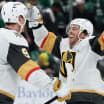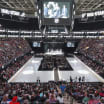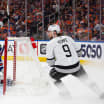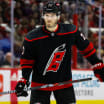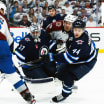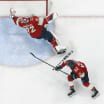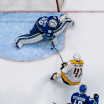NHL.com is providing in-depth analysis for each of its 30 teams throughout August. Today, the biggest reasons for optimism and the biggest questions facing the Pittsburgh Penguins:
After an improbable run through the second half of last season to the Stanley Cup, the Pittsburgh Penguins are primed for a potential repeat.
Reasons for optimism, questions facing Penguins
Battle for No. 1 goaltender main concern for defending Cup champions

© Len Redkoles/Getty Images
By
Wes Crosby
NHL.com Independent Correspondent
The Penguins will look nearly identical to the group that won the Cup in June. With veteran forward Matt Cullen returning for a 19th NHL season, Pittsburgh's four lines are intact, and its defense will be slightly altered, despite defenseman Ben Lovejoy leaving for the New Jersey Devils as a free agent.
Outside of the goaltending situation, almost everything seems set in stone for Pittsburgh nearing the end of a quiet offseason.
Penguins 30 in 30: Season outlook | Top prospects | Fantasy outlook
Here are four reasons for optimism entering this season:
1. Evgeni Malkin is healthy
After returning from an elbow injury that sidelined him for five weeks, Malkin wasn't himself throughout the Stanley Cup Playoffs. He finished with 18 points (six goals, 12 assists), showing flashes of brilliance in 23 games. That would be an excellent output for most other NHL players, but for Malkin, it appeared a bit lackluster. That shouldn't be the case this season.
On June 23, the Penguins announced Malkin wouldn't need surgery on his injured left elbow. After rehabilitating and vacationing in Miami most of the offseason, Malkin is unlikely to miss any playing time once Pittsburgh's regular season begins against the Washington Capitals on Oct. 13, after he competes for Team Russia in the World Cup of Hockey 2016 beginning Sept. 17.
"I'm OK because most guys play with injuries," Malkin said. "Most players play with injuries, but I feel very good. … I'm not young anymore (he turned 30 on July 31). I need to work a little harder. I need to practice a little bit more and have fun with my family, work and train."
2. Familiar cast of characters
The Penguins roster should look pretty close to the way it did in June, with the exception of Lovejoy. The stability Pittsburgh was able to maintain throughout the offseason has it in position to compete for the Stanley Cup again.
The Penguins' speed proved to be a problem for opponents throughout the playoffs, and that shouldn't change. Forwards Carl Hagelin, Phil Kessel, Conor Sheary, Bryan Rust push the attack with a north-south style coach Mike Sullivan consistently emphasized after being hired Dec. 12.
After seeing Sullivan's style work, Pittsburgh should again be one of the most aggressive teams in the NHL.
"I thought the players were very receptive to what we were trying to preach to them," Sullivan said. "It was a process, I think, to get us to where we wanted to be. … I think anytime as a coach, when you're trying to play a certain way and you're trying to sell a certain way to your players, ultimately you have to have the results to back up what you're selling."
Kessel could miss the start of the season recovering from hand surgery he had on July 8, and general manager Jim Rutherford said this week he is optimistic that other injured Penguins, including defensemen Trevor Daley (broken ankle) and Kris Letang (foot), and forwards Rust (hand), Nick Bonino (elbow infection) and Patric Hornqvist (hand) will be ready to play against the Capitals.
3. Sidney Crosby looks like himself
Early last season, it appeared Crosby's best days may have been behind him. Then December came and he again claimed his spot as one of the League's best players.
Without Crosby rebounding in the way he did in the second half of the season, the Penguins might not have made the playoffs, never mind win the Stanley Cup. He finished with 85 points (36 goals, 49 assists) in the regular season and had 19 points (six goals, 13 assists) in the playoffs to win the Conn Smythe Trophy.
If Crosby maintains his performance from late last season, Pittsburgh likely will get off to a much better start.
4. Talented depth up front
During the Eastern Conference Second Round against the Capitals, Sullivan was asked about the Penguins' third line. Before answering, he had to ask which line was considered the third.
Most consider Crosby's line the first, Malkin's the second, and the "HBK Line" of Bonino centering Hagelin and Kessel the third. Pittsburgh doesn't see it that way, especially because Hagelin, Bonino and Kessel made up its most productive line throughout the postseason; they were three of Pittsburgh's top five scorers in the playoffs.
That forward depth caused matchup problems for opposing coaches, a trend that could continue once Kessel is healthy.
Here are three key questions facing the Penguins:
1. Who gets the bulk of starts in net?
The Penguins are fortunate to have Matt Murray and Marc-Andre Fleury, but only one can start at a time.
Murray staked his claim with a strong playoff run in his rookie season (15-6, 2.08 goals-against average, .923 save percentage). Fleury, Pittsburgh's franchise goalie of the past decade, was having his best regular season before sustaining a second concussion on March 31 that allowed Murray to take over.
Each is worthy of the starting role, but it likely will take more than training camp to find a starter.
2. Will Derrick Pouliot rise to the occasion?
Pouliot entered last training camp with a good chance of making Pittsburgh's roster. Once the season began, he found himself playing for Wilkes-Barre/Scranton of the American Hockey League and didn't see NHL action until Jan. 23.
The 22-year-old defenseman has huge upside and could compete for a larger role with Lovejoy no longer in the picture and Daley recovering from his injury. Pouliot has the tools to work in an up-tempo style and cater to Sullivan's system.
3. Can Chris Kunitz keep up?
Throughout last season, Kunitz didn't seem to have the same offensive punch he once possessed playing wing on a line with Crosby. That changed when Kunitz was moved to Malkin's left wing in the playoffs, which helped him score 12 points (four goals, eight assists), his most since scoring 14 in the 2009 postseason.
Despite that surge, Kunitz, 36, remains the biggest question mark on Pittsburgh's top three lines. It remains to be seen if Kunitz can continue to throw his body around (264 hits last season) while contributing offensively.




